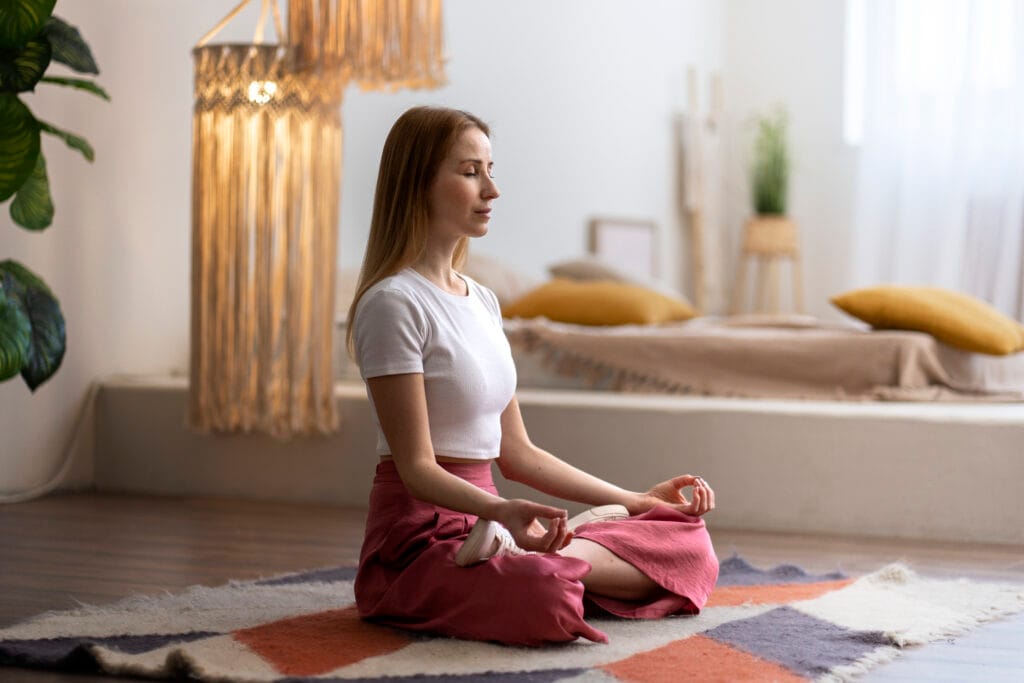How to Start a Mindful Meditation Practice for Beginners?
- Published -
- Reading Time: 9 minutes
-
Written by - Rajat N

Introduction:
Is it possible to change your life by just dedicating 10 minutes a day? Well, let’s find out.
Did you know practicing meditation for a mere 10 minutes daily can elevate focus by 30% and help reduce stress by 25%? Mindful meditation, unlike other forms of meditation, is straight forward and easy to practice. In a world with endless distractions, this practice helps offer tremendous clarity and balance. But if you have never meditated before, how do you begin? This beginners guide will help you unpack the whole deal step by step, debunk popular myths, give valuable expert opinions, and share possible implementation of mindfulness in undertaking practical daily activities.
source –
Note: The video content is intended to provide supplementary information and a different perspective on the discussed topic. All information and advice presented in this article are based on expert guidance and review.
1. Mindful Meditation: What It Is and Its Benefits
Tip: Figure out the concept of mindful meditation and the advantages it provides.
Solution: Mindful meditation focuses on what you are currently experiencing without any kind of judgement. This practice is distinct as it enables the participant to have a mental awareness of one’s feelings, thoughts, and environment without actually getting absorbed into it.
Mindful meditation equips the brain to pause, process and respond more thoughtfully,’ says Dr.Lisa Feldman who is a mindfulness neuroscientist.
Case Study: After a month practicing mindful meditation during work lunch breaks, Emily, a corporate lawyer, was more productive at work and saw significant reductions in her anxiety level.
Data Point: A study reported by the American Psychological Association indicates that 58% of people who practice mindful meditation experience a reduction in anxiety symptoms.
Myth Buster: Quite the contrary, meditation is not about achieving perfection and clearing the mind. Rather, it is focused on observing thoughts and gently drawing one’s attention back to the present moment.
2. Setting Realistic Expectations: Start Small, Stay Consistent
Tip: Initially, practice undemanding attention exercises for a few minutes, then gradually extend the duration.
Solution: Seek to meditate for only 5-10 minutes daily. After a while, increase the time to 20-30 minutes.
Expert Insight: “The key to meditative practice is consistency…it is the most crucial element albeit the most ignored. Everyone has a few minutes to spare, so spending those minutes on meditation is always beneficial,” states mindfulness coach John Barrett.
Case Study: After making morning 5-minute meditations a part of his routine for three weeks, Rajesh, a busy entrepreneur, reported enhanced feelings of inner tranquility and remaining less reactive to stressors.
Data Point: Research indicates that a single 8 week long meditation is enough to enhance parts of the brain related to memory, empathy and stress management.
Myth Buster: You do not have to devote hours upon hours in order to reap the benefits of meditation. Every little bit adds up over time.
3. Your Meditation Space: A Place of Stillness and Repose
Tip: Setting a place specifically for meditation can help develop the habit.
Solution: Locate a place in your house that is peaceful and warm. Make the area more inviting with cushions, candles, or soothing sounds.
Expert Insight: “Your environment influences your practice. A separate area aids in notifying your mind that it is time to unwind and concentrate,” in the words of interior wellness designer, Mia Carter.
Case Study: Sarah, a graphic designer, managed to convert a section of her living room into a meditation corner. Now, she is way more likely to meditate on a daily basis.
Data Point: Environmental psychology shows that focus and distractions are affected positively by 45% when a clutter free serene space is provided.
Myth Buster: If anything, the opposite is true. All that is required is simplicity when furnishing a meditation space which makes a peaceful environment.
4. Selecting the Best Technique: Choose the Most Efficient One
Tip: Search for different styles and see which one suits best.
Solution: Some popular techniques include:
Focused Attention Meditation: concentrate on your breath or the object in the room.
A body scan entails concentrating on specific sections of the body. Loving-kindness meditation encourages a feeling of compassion and kindness.
Guided meditation involves following an instructor’s directions from a teacher or a mobile application. As noted by Rebecca Hale, a meditation instructor, “There’s no one-size-fits-all approach.
Try different techniques to find what aligns with your needs and personality.” David, an engineer, had a problem doing regular breathing exercises but was able to become acquainted with guided meditations via an application.
According to a 2023 survey, 70% of novices practice meditation actively after finding a type that fits their lifestyle. Contrary to the popular belief that meditation is the act of remaining in a cross-legged position without any noise, there are many other ways to meditate. You can also talk without shifting your body in any manner.
5. Overcoming Challenges Related to Distractions and Restlessness
This can be achieved by acknowledging distractions as part of the process and trying to shift the focus gently elsewhere. In instances where wandering of the mind occurs, guided meditations/singing background music can be employed.
You also don’t have to judge yourself. As Dr. Emily Connor explained, “Distractions are normal. Treat them as opportunities to practice mindfulness,” so rest assured, mindful practices such as these can go a long way.
Case example: Anna, who is a teacher, could not put her racing thoughts to rest when trying to meditate. The use of a mantra helped her maintain focus.
Data point: The chances of distraction during meditation is 60% for beginners as shown in research, but regular practice helps in reducing the wandering mind phenomenon within a month by 25%.
Myth Buster: If your mind wanders, it does not mean you are ‘bad’ at meditation. It’s a integral part of the learning process.
6. Making Meditation a Habit: Incorporating it to Daily Activities
Tip: You can easily incorporate meditation to your lifestyle by pairing it with an existing habit that you already do.
Solution: You can choose to meditate at a particular time of the day such as in the morning, after lunch , or before going to sleep. You can also set up reminders or try habit stacking, such as meditating after brushing your teeth.
Expert insight: “We can look at habits as patterns, and consistency helps in the formation of these patterns. Associate meditation with other daily tasks, this will help you build it as a habit,” habit coach James Ford explains.
Case example: Maria, an occupational healthcare worker, stayed consistent for over a year by meditating for 5 minutes before her morning cup of coffee.
Data point: Stacking new habits on top of already existing ones has been shown to increase the chances of adopting new habits by 38%, according to a study in the European Journal of Behavioral Psychology.
Myth Buster: Meditation is achievable by simply incorporating it into one’s daily routines. It does not necessitate having hours of free time.
7. Tracking Your Progress: Celebrate Small Wins
Tip: To maintain motivation while meditating, keep track of your progress.
Solution: After every meditation session, write down your feelings, insights, and experiences in a journal. In a matter of time, you will be able to track changes in your level of focus, mood, and stress.
Expert Insight: According to off the record Dr. Priya Sharma who specializes in mindfulness, Progress tracking acts as a motivating factor on personal developement reflection.
Case Study: To stay accountable, Jack, a university student, utilized a meditation application and documented each of his practice sessions. Observing his progress motivated him to persist with his practice.
Data Point: A Headspace survey indicated that those vigilantly keeping track of their meditation are at an increased likelihood of sustaining a healthy meditation habit by 47%.
Myth Buster: The true measurement of meditation is not how well one can meditate, but the amount of positive life changes made after practicing it.
8. Integrating Mindfulness into Daily Tasks: There Is More to It Than Staying Still
Tip: Carry out your mundane daily chores brainlessly while (barely) concentrating to enhance your focus.
Solution: While performing an activity, such as walking or eating, incorporate mindfulness by concentrating on the smells, sounds, and how each movement feels.
Professional Insight: Mindful walking is a form of moving meditation that is simply walking with attention to one’s surroundings. Tara West, an instructor for mindfulness practices explains further, “You don’t have to be in a comfortable position meditating. One can equally be mindful while moving.”
Case Study: Tom, a software engineer, was able to bring down stress levels at work through mindful walking during his lunchtimes. This greatly shifted his attention to the work at hand.
Data Point: A study conducted in 2020 revealed that routine activities such as household chores can boost one’s level of mindfulness by 22%
Myth Buster: ‘Being still’ is not a criterion for being able to consistently practice mindfulness. We now live in times where being aware can happen everywhere and everyday activities can accommodate it.
9. Using the Apps or Any Digital Devices to Promote Better Practicing
Tip: Try videos, wearables, and other apps to make meditation even more enjoyable.
Solution: There are now several applications, including Calm, Headspace, and Insight Timer which offer timers, meditative guides, and even progress tracking aids. Smart watches are now able to capture heart rate and one’s stress level which aids in monitoring practice.
Expert Insight: According to Rachel Gomez, an expert in digital health, “Beginner meditators can find practicing much more enjoyable due to the accessibility technology provides.”
Case Study: Using the Calm app, Kevin, a marketing executive set aside 10 minuets of his day for guided meditation. These short meditations fit perfectly in his schedule enabling him to manage his time more effectively.
Data Point: App users accustomed to mindfulness practice, according to a survey done in 2023, reported an increased satisfaction of up to 65%.
Myth Buster: Technology does not draw attention away from mindfulness. When technology is utilized thoughtfully, it enhances the experience.
10. Managing Expectations: Meditation is an Expedition to Undertake, not a Problem That Needs to be Solved
Tip: Pay attention to the activity in progress instead of worrying about the outcome.
Solution: Let patience and curiosity guide your exploration of meditation. Embrace the fact that some days tend to be easier mentally than others.
Expert Insight: “There is no perfect way to meditate, there is a way to improve. Indeed, meditation is a progress orientated activity. Trust the process. There is no need to achieve the outcome immediately”, says marketing expert Erin Moore.
Case Study: Alice, journalist by profession, was initially very irritated because she was devoid of any changes. Eventually, she began to notice that even small improvements such as concentration and reduced irritability were reasons to celebrate.
Data Point: It is reported by UMass that measurable results are likely only after around 6-8 weeks of practicing meditation consistently.
Myth Buster: Meditation does not serve as an instant solution for every single concern a person faces. Gaining its advantages is a gradual process that requires continuous input from the individual.
Final Thoughts: Let the Mindfulness Journey Commence
A mindful meditation practice can be easily incorporated into your daily life. The fundamental secret is to set achievable goals, use the right methods, and be persistent. Each person’s journey is theirs and theirs alone. Make sure you appreciate the journey and relish the progress you make, while also finding a sense of tranquility, focus, and balance in your life.
Embracing meditation brings forth a diverse sense of fulfillment. By focusing on the underlying reasons to embrace meditation, daily application becomes achievable. Above everything, hope for improvement day in and day out.
FAQs
- What is mindful meditation, and how does it differ from other forms of meditation?
Answer: Mindful meditation is the process of meditating while being aware of your surroundings and appreciating the present. This process of meditation includes watching thoughts, feelings and body sensations without judging. Unlike other types of meditations which may involve chanting or visual imagery, mindfulness involves being present and accepting everything without any judgment.
- Which is the optimal period to spend while meditating for the first time?
Answer: For beginners, you can start with 5 to 10 minutes daily. After some time, gradually increase the duration to 20-30 minutes once comfortable. One key point is that duration is less relevant than consistency in the start.
- Which is the most suitable time during the day to mediate mindfully?
Answer: The better period is when one can be consistent. Many set people set morning as an ideal time to practice it while other set evening time to wind down. This allows for a positive setting for the day or night. Try out and find what suits your schedule.
- Is any specific space or meditation resources required for the purpose of meditating?
Answer: No special resources are expected. It is enough to have a clutter free zone with a comfortable chair or cushion for sitting. Having a designated space for meditation may be helpful in developing the habit but it’s not a must.
- What can I do to concentrate if I keep losing focus?
Answer: While it’s expected for your thoughts to drift away, this should not concern you. During such moments, kindly pay attention to your breath or whatever you were focusing on. This helps to cast a stronger focus on everything over time.
- Is it possible to do mindfulness meditation and multi-task at the same time?
Answer: Absolutely, one can practice mindfulness during simple tasks such as walking, eating, and washing dishes. The important aspect here is to pay close attention to the task at hand and use all your senses for that purpose.
- In how much time does one start to reap the benefits of practice in mindful meditation?
Answer: One may observe minor improvements, though, in few weeks if practiced consistently, like increased concentration or lesser stress. Major transformation in emotional regulation and mindfulness take place in the 6-8 weeks span.
- Is there any religious or spiritual context for mindful meditation?
Answer: No, mindful meditation is not affiliated with any religion; it’s simply secular and primarily focuses on emotional and mental well-being. It does have connections to Buddhism but can be practiced by all people from different cultures without any religious attachments.
- What can I do if I feel bored or fidgety during meditation?
Answer: It is perfectly acceptable to feel fidgety or bored, as it is part of the human experience. Acceptance is one of the most valuable components of mindfulness, so allow yourself to feel these emotions grounded in gentleness and apply focus to your body or breath. It is the best way to reset and re-calibrate one’s thought process.
- How can I monitor my growth while practicing mindful meditation?
Answer: Change can happen gradually, and can be gauged by changes in stress levels, mood, or even one’s focus. One can assess progress overtime by logging and journaling their practice in meditation apps where progress is not guaranteed to be obvious at first. So change in one’s ordinary behavior puts the user on the right path.






